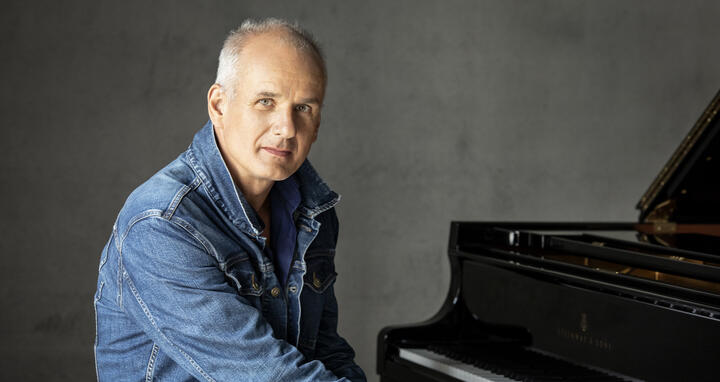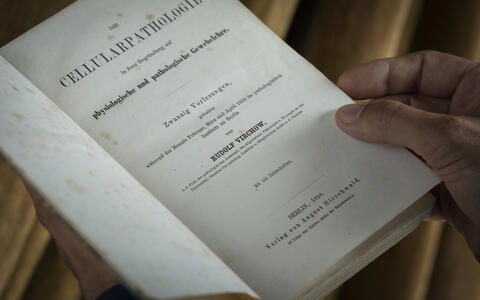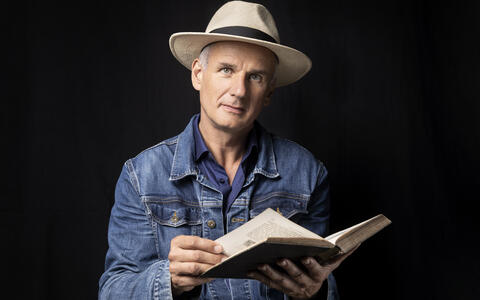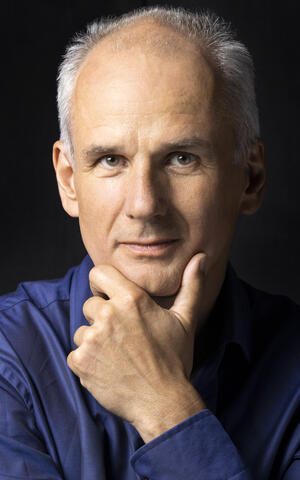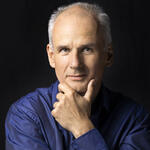The visionary
Professor Nikolaus Rajewsky places an old book on the table. The cover is tattered at the edges; the pages are dotted with mold stains caused by damp and microbes. The word Cellularpathologie is printed in fine serif typeface on the title page. Inside are 20 lectures given by Rudolf Virchow in 1858 at the Pathological Institute of Berlin. “Virchow theorized in these lectures that, to cure human diseases, we have to understand what happens in cells when they get sick,” says Rajewsky.
"Cellularpathologie" summarizes 20 lectures given by Rudolf Virchow in 1858.
The director of the Berlin Institute for Medical Systems Biology (BIMSB) of the Max Delbrück Center for Molecular Medicine (MDC) sits at his desk, crosses his legs, runs his hands down the back of his head and begins to talk about his vision of the medicine of tomorrow with a calm voice and determination in his eyes. Behind him hangs an honorary doctorate certificate from Sapienza University in Rome. At the award ceremony, Rajewsky the pianist performed Rachmaninov’s suites for two pianos. “We now have the technology to make Virchow’s dream a reality,” he continues. “We are able to digitize hundreds of thousands of cells at once and witness how they develop and react to neighboring cells or to their environment. This will revolutionize medicine,” says Rajewsky the visionary.
At the center of this vision are a number of new technologies that allow the processes in individual cells to be monitored with unprecedented precision. The depth and accuracy of the information about biological processes that single-cell methods can deliver has far-reaching implications for basic research and clinical practice. For the first time, it is possible to follow the development of diseases at the level of individual cells in order to steer them back towards a state of health at an early stage – ushering in the arrival of a new, cell-based medicine.
Experiments on mini-brains
Over the course of its life, a cell will continually refer back to instructions contained in the genome. It “reads” the genome as one would a manual to find out how it should react to external influences. And researchers can observe this process using single-cell methods. They take cells from patient tissue – which contains thousands of cells per sample – and pack each one in small droplets in order to then observe which genes it is reading and translating into proteins. This technique produces huge amounts of data that are analyzed with the help of artificial intelligence.
Virchow was the first to recognize the need to understand cellular processes in order to cure human diseases. Now the technology is available, says Nikolaus Rajewsky.
And that’s not all: Rajewsky and his team have also developed a method that allows them to look at each individual cell in a section of tissue simultaneously and to reconstruct where they were located in the tissue after sequencing. “This gives us a spatial map of gene expression and can tell us which genes are turned on or off in which precise location and in which cell – as well as the effects that has,” explains Rajewsky. This works, for example, in brain organoids made from patient stem cells. “Brain organoids are living ‘mini-brains,’ complete with firing neurons, and they represent a massive breakthrough because they allow us to conduct experiments on human nervous tissue.” At BIMSB, for example, they infected these mini-brains with herpes viruses suspected of having an impact on Alzheimer’s disease. They then used single-cell techniques to check which cells actually became infected and how they reacted – whether they died, changed or remained healthy. “The vast complexity of the interaction needs to be understood if we want to intervene therapeutically and target the cells with drugs.”
Between Beethoven and stochastic processes
Nikolaus Rajewsky’s drive to understand the world began at a young age. His father is a renowned immunologist and his mother was a political scientist. At just 15 years of age, he already enjoyed exploring the theory of relativity and quantum physics, and could spend hours searching for meaning in numbers and formulas. At 23, having graduated with a degree in physics and mathematics, he decided to study piano alongside his doctorate in physics – Beethoven in the evening, stochastic processes in the morning. “Whenever I grew tired of one, I derived even more enjoyment from the other,” recalls Rajewsky the ambitionist.
I find playing the piano a beautiful way to engage with life and respond to what’s going on in the world.
He never lost his passion for the piano: Rajewsky has one grand piano in the conference room at BIMSB and another one at home, so he can play whenever the mood takes him – to experience the joie de vivre of Rachmaninoff in the morning, for example. “I find playing the piano a beautiful way to engage with life and respond to what’s going on in the world.”
His period as a student in Cologne was followed by several years in the U.S., which included a postdoctoral position at an institute for statistical physics and, finally, the decision to switch to biology. “I took a summer course, purely out of interest, called ‘Biology for Mathematicians,’ which taught me that biology was on the cusp of turning quantitative and that you can measure the processes of life,” Rajewsky recalls. “I just thought it sounded like a great adventure!”
He immediately applied to Rockefeller University in New York, filled his knowledge gaps in biology, and became one of the first to apply digital methods to research into bacteria, fruit flies and human cells. Soon after, he became a professor at New York University, where he investigated the function of microRNA in gene regulation – and gained world-wide recognition for his work.
Working in the vicinity of Virchow
When he came to the MDC in 2006, he continued to combine computational methods with biochemistry and molecular biology. He set up a lab to study the mechanisms of gene regulation that are involved in cellular decision-making – particularly the role of RNA in the translation of genetic information. He also poured all his efforts into creating an institute to advance systems biology in Berlin. It took a few years, but his efforts paid off and BIMSB was founded. In 2019 the Institute’s research groups moved into a new building on Humboldt-Universität’s Campus Nord, in close proximity to Charité – as well as Rudolf Virchow’s former place of work. The state-of-the-art facility was opened by Federal Chancellor Angela Merkel.
Nikolaus Rajewsky
At a conference in Jerusalem in 2015, Rajewsky realized that medicine was once again on the verge of something huge. “Israeli and U.S. researchers back then were presenting single-cell techniques,” he recalls. “I went back to my lab and said, ‘We need to do this, now!’” A young biochemist on his team took the reins and managed to get the method up and running in just one summer. Rajewsky’s research group was one of the first to apply – and further develop – this new technique of single-cell analysis in Europe. They are able to sequence the approximately 6,000 cells of a fruit fly embryo and reassemble them on the computer to form a virtual organism, which they can then scrutinize cell by cell to see which genes are active where and how they change the cells. “We’re at a point now where the data available to us is so precise that we can begin to predict how cells will change,” he says. Science magazine even recognized the team’s work as part of its 2018 “Breakthrough of the Year.”
Realizing the dream of a “cell hospital”
Rajewsky loves it when people come together to create something new, like BIMSB and the Berlin Institute of Health at Charité (BIH) with their joint focus on single-cell biology, or – his latest brainchild – a future “cell hospital” in Berlin. This clinic would unite various disciplines and institutions to search for molecular targets for therapeutic approaches using single-cell techniques. Rajewsky has held countless discussions with colleagues and politicians on the topic, and even published his proposal in the German newspaper Tagesspiegel. And it has paid off: On October 13, 2021, the 200th birthday of Rudolf Virchow, the MDC, Charité – Universitätsmedizin Berlin, the BIH and Technische Universität Berlin will present plans for the Berlin Cell Hospital to the public.
We want to use interceptive cell-based medicine to close the huge gap between classic prevention and treating symptoms.
And then there’s the LifeTime consortium, where Rajewsky succeeded in pooling the single-cell expertise of 90 research institutes and more than 80 companies Europe-wide. Together with Geneviève Almouzni of the Institut Curie in Paris and more than a hundred other scientists, he published a vision in the journal Nature of a cell-based medicine that can successfully intercept diseases long before they break out. “We want to use interceptive cell-based medicine to close the huge gap between classic prevention and treating symptoms,” says Rajewsky the strategist.
Or is it Rajewsky the researcher? “I’m happiest when I can go into the lab and discuss data with my team,” says Rajewsky. So why put all this effort into creating a systems biology institute? A future cell hospital? A European consortium? “I guess that’s my enthusiasm for making ideas happen,” he says, laughing briefly at his answer and then collecting his thoughts. “No, at its core it’s about making progress in science and health research and doing something deeply human: helping sick people.”
Text: Mirco Lomoth
Further information
- Press release: A leap into the future with Virchow
- Kick-off event Virchow 2.0 – Berlin Brandenburg innovation cluster for cell-based medicine
- Berlin should establish a cell hospital – a proposal and call to action by Nikolaus Rajewsky (German only)
- Nature article about LifeTime: LifeTime and improving European healthcare through cell-based interceptive medicine
- LifeTime website
- Press release : BIH, MDC and Charité launch a new research focus
- Berlin Institute for Medical Systems Biology (BIMSB) of the MDC

